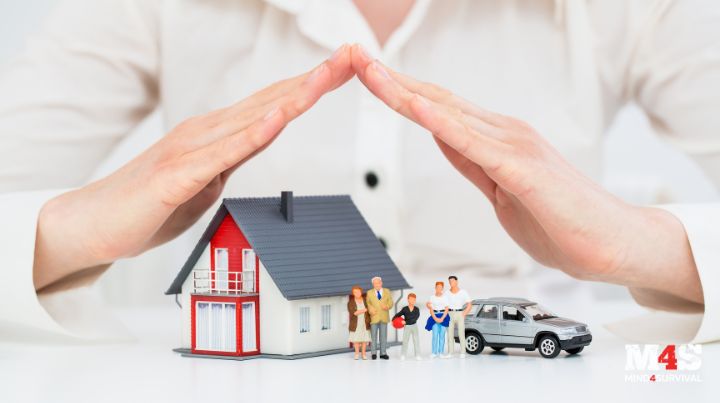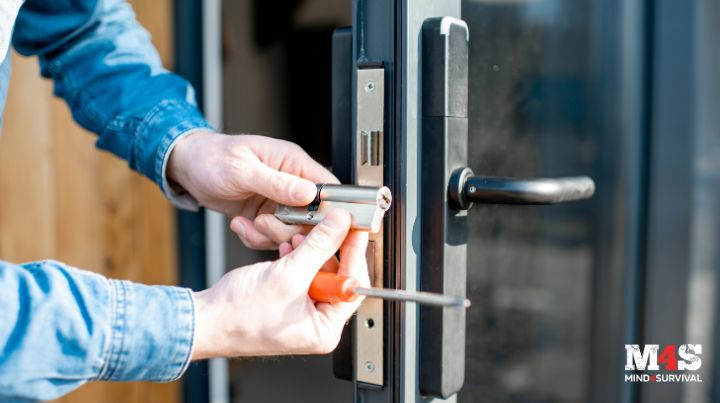How to Make Your Home More Safe and Secure

Creating a secure and safe home environment is an essential preparedness step for any homeowner. This article will discuss how to make your home safe and secure, ensuring it becomes a haven for you and your loved ones. By implementing these strategies, you’ll be ready to face a variety of scenarios confidently, knowing your home is well-protected.
Quick Look at What You’ll Learn
The Five Ds of Home Security
Securing your home effectively involves a strategy known as the Five Ds of Home Security: deter, detect, deny, delay, and defend. This approach helps establish a protective perimeter around your home, ensuring a safe environment for you and your family.
Deter
The first step is to make your home an undesirable target for criminals. Simple methods include:
- Installing security signs.
- Keeping a vehicle in the driveway.
- Having a dog or displaying signs of one.
These measures create doubt in potential intruders’ minds, making them think twice about targeting your home.
Detect
When deterrence fails, detection comes into play. Use both high-tech and low-tech methods to discover intruders. Low-tech options include keeping a dog and trimming plants around your home to eliminate hiding spots. High-tech solutions involve alarm systems, CCTV, and motion-sensor lights. These tools help you identify potential threats early.
Deny
The next step is to prevent access to your home. Reinforce doors with strong locks and door frames, use thorny plants around windows, and always lock your windows. Simple upgrades like longer screws in door hinges and frames or products like Door Armor significantly enhance your home’s security.
Delay
If an intruder attempts to enter, delay their progress. Reinforcing doors and locking windows are key tactics. The more time it takes for an intruder to gain entry, the more time you have to react, whether by calling for help or finding a safe place.
Defend
Defending your home should be a last resort and only done if necessary. Discuss potential actions with your family beforehand. If you must act, do so confidently and quickly, always prioritizing your safety and that of your family.
Enhancing Perimeter Security:
Enhancing perimeter security is vital because it is your home’s first line of defense. A well-secured perimeter deters potential intruders, making it harder for them to gain access. It also provides early warning signs of unauthorized entry, allowing you to react more effectively. By strengthening fences, gates, and other perimeter security points, you can create a formidable barrier that significantly reduces the risk of break-ins and ensures safety and peace of mind for you and your loved ones.
Fencing and Gates:
- Install a Sturdy Fence: A solid fence acts as the first line of defense. Choose materials that are difficult to climb or breakthrough.
- Secure Gates: Ensure all gates have robust locks. Self-closing and self-locking mechanisms add convenience and security.
Lighting:
- Motion Sensor Lights: Install motion sensor lights around your home’s exterior. These lights deter intruders and alert you to their movement.
- Exterior Lighting: Keep your home well-lit at night with strategically placed lights around entry points and pathways.
Strengthening Entry Points
Strengthening entry points such as doors and windows is crucial because these are the primary targets for potential intruders. Reinforced doors and secure locks can significantly deter break-ins, providing a solid defense against intruders.
Doors:
- Upgrade Locks: Start with your front door. Install high-quality deadbolts and consider adding a secondary lock, such as a chain lock or a slide bolt.
- Reinforce Door Frames: Strengthen the door frames with metal strike plates and longer screws to prevent forced entry.
- Use Door Jammers: Door jammers and similar devices provide an extra security layer by bracing your door against forced entries.
Windows:
- Install Window Locks: Make sure all windows have functional locks. Consider adding supplemental locks for extra security.
- Use Security Film: Apply shatter-resistant film to windows. This film makes glass harder to break, adding another barrier against intruders.
- Consider Window Bars: For ground-level windows, decorative window bars can provide additional security without sacrificing aesthetics.
Implementing Advanced Security Systems
Implementing advanced security systems is crucial because it significantly enhances your home’s protection. These systems, including alarms, surveillance cameras, and smart doorbells, provide real-time monitoring and alerts, helping you respond swiftly to potential threats. Advanced security features deter criminals, ensuring that your home remains a less attractive target. Moreover, professional monitoring services can notify authorities immediately during emergencies, providing an added layer of safety.
Alarms and Surveillance:
- Install a Security System: A comprehensive home security system can include alarms, motion detectors, and cameras. Modern systems offer remote monitoring via smartphones.
- Surveillance Cameras: Position cameras to cover entry points, driveways, and other vulnerable areas. Visible cameras can deter potential intruders.
- Smart Doorbells: Video doorbells allow you to see and communicate with visitors remotely, adding a layer of convenience and security.
Security Monitoring:
- Professional Monitoring: Consider a security service that offers 24/7 monitoring. These services can alert authorities in case of an emergency.
- DIY Monitoring: If professional services are undesirable, DIY systems with app notifications can inform you about your home’s security status.
Creating Safe Rooms
Creating safe rooms in your home is a great option to ensure your family has a secure place to retreat during emergencies. These rooms offer protection against intruders, severe weather, and other threats. Equipped with essential supplies and fortified against forced entry, safe rooms provide peace of mind and a reliable refuge when needed. They help reduce anxiety during crises and ensure your loved ones have a designated area to stay safe until the danger has passed.
Designated Safe Areas:
- Choose a Secure Room: Select a room in your home that can serve as a safe space during emergencies. Ideally, it should have minimal windows and a sturdy door.
- Equip the Room: Stock it with essential supplies such as water, non-perishable food, first aid kits, and communication devices.
Reinforcing Safe Rooms:
- Fortify the Door: Install a solid core door with a strong lock. Reinforce the door frame and hinges to withstand forced entry.
- Communication: Ensure the room has a reliable way to communicate with the outside world, such as a charged cell phone, landline, or a two-way radio.
Preparing for Various Scenarios
Preparing for various scenarios is crucial as it equips you to handle different emergencies effectively. Whether it’s a fire, natural disaster, or a medical emergency, having specific plans and supplies in place can significantly reduce the impact and help ensure your family’s safety. By anticipating potential threats and preparing accordingly, you foster resilience and confidence, knowing you can manage unexpected situations. This proactive approach safeguards lives and minimizes panic and chaos during critical moments.
Fire Safety:
- Smoke Alarms: Install smoke alarms on every floor and in every sleeping area. Test them regularly and replace batteries as needed.
- Fire Extinguishers: Keep fire extinguishers in accessible locations, such as the kitchen and garage, and learn how to use them effectively.
- Escape Plans: Develop and practice escape plans with your family. Ensure everyone knows at least two ways out of each room and floor in your house.
Natural Disasters:
- Emergency Kits: Assemble emergency kits that include supplies for at least 72 hours and store them in easily accessible locations.
- Secure Heavy Items: Secure heavy furniture and appliances to walls in earthquake-prone areas to prevent tipping.
- Weatherproofing: Install storm shutters and reinforce the roof to protect your home against floods, hurricanes, and other natural disasters.
Build a Support Network
Building a network of supportive connections is crucial for enhancing overall security and preparedness. When you have a group of like-minded, values-aligned people who know and trust each other, they can share information about potential threats, collaborate on safety initiatives, and offer support during emergencies. A strong network creates a sense of collective responsibility, making addressing and preventing issues easier. This cooperative approach boosts individual safety and fosters a resilient and supportive environment where everyone feels more secure and confident in their preparedness efforts.
- Neighborhood Watch: Join or start a neighborhood watch program. Knowing your neighbors and working together can enhance overall security.
- Share Information: Keep each other informed about suspicious activities and share tips on home security measures.
Regular Maintenance and Updates
- Routine Checks: Regularly inspect and maintain security features. Check locks, alarms, and cameras to ensure they are functioning correctly.
- Stay Informed: Stay current with the latest security technology and practices. Updating your system and knowledge can help you effectively address new threats.
The Bottom Line on How to Fortify Your Home for Safety and Security
Fortifying your home is about creating a safe and secure environment for your family. By focusing on perimeter security, entry points, advanced systems, safe rooms, and preparedness for various scenarios, you can build a robust defense against potential threats. Building a solid network and maintaining regular maintenance will enhance your home’s safety. Embrace these steps, and you’ll transform your home into a confident sanctuary.
What are your thoughts or questions about home safety and security? Tell us in the comments below.
Stay safe,

Read the full article here











